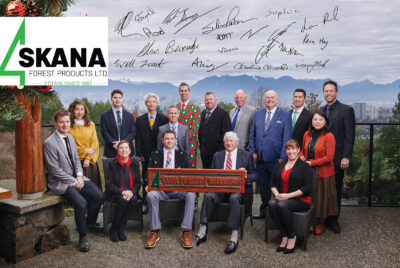Fires, weather, housing starts and interest rates dominated the discussion this period. An Ontario manufacturer indicated that “we’re quiet right now. It feels like the dog days of summer. You know, when housing starts went from 1.61 million in the U.S. to 1.4 and change, that really seemed to cut the market off at the knees. That was really compounded by the weather that we’d had at that point. July was like record high temperatures and I mean, if it’s 115 degrees in Phoenix, I don’t know how many walls are being put up, right?”
A Quebec wholesaler remarked that “the market took a punch from several directions, because the starts came off, the weather was terrible, and then the Federal government put the interest rates up again, so we’re suffering from those actions. I’m hoping that in the fall we’re going to see some more activity just because the level of U.S. housing starts are still decent numbers historically. I don’t think people have a lot of wood. I think buyers are exercising a lot of restraint, they’re buying kind of what they need. The futures yesterday bumped up a little bit, and then it’s up a little bit again today, so maybe we’re going to find some bottom over the next couple of weeks. The crystal ball’s not very clear right now, just because interest rates are still inching up. I don’t think the Feds have decided yet whether they’re going to hold here or whether they’re going to continue to raise interest rates, but in the short term here right now, it feels like it just wants to go down.”
“Things are not moving great, pretty much across the board now,” noted a wholesaler from Ontario. “There’s nothing that’s really jumping out at us as a hot item or is that is tight. 2×8 eights and tens as well as 2×10 tens maybe, items like that are a bit tighter than others. But if you just look long enough, you’re going to find them. I heard from the LVL producers is the I-Joist producers in the U.S. have got solid order files, like six to eight to nine weeks out. They’re running at pretty much full capacity. So that’s one item that is strong. The timing was good for the Quebec construction holiday, in the sense that the Quebec firms weren’t actively taking big counters. A lot of them were shut down and they are all coming back on stream this week and next week. So, they’re coming into a market that’s very, very soft. So that just adds a little bit more potential downward pressure.”
According to a Quebec-based producer, “Most people would tell you that we were flat for many months to start the year, in terms of pricing. Then the fires in Quebec certainly got the market going. It probably rallied the market $100. Now we are giving back, I would say 50 percent to 70 percent of that rally in terms of price, so the market seems to be balanced when there was a little imbalance. It gave us a rally, but it was completely supply driven. The demand dynamic is probably the same, and now we’ll see where prices land. We’re not back to where we started, but we’re getting closer and closer every day. I guess you would say interestingly that the low grade, the economy and No. 3 are kind of holding their own, relative to the No. 2’s. It was the No. 2’s and the studs that gained when the market rallied. It was like the No. 2 in studs that reacted to those fires. The No. 3’s seem to have been steady flat for month after month. The low grades are selling well. The No. 2 grade is coming off more than the low grade, percent wise. Looking ahead to the next couple of months? I am an optimistic guy, I always think that it’s going to get better, but we’ll see how she plays out. I mean, it’s really been a balanced market all year.”
Noted an Ontario producer, “There was like a big rally, in terms of demand and price increases, through June and the early part of July. Since then, we’ve entered a slower period, where the market lagged a little bit. It’s still lagging. That’s a function of a lot of lumber being sold though in North America. It is also due to the fact that we’ve been going through the middle of the summer with a lot of heat in the U.S. and the south and less activity in construction. So it’s been a struggle for mills, all over North America to, to be able to sell their products. You could say prices have melted a little bit. We’ve given back most of the price increases that we had in June and early July, at this point in time. That period of giving back is slowly diminishing and we’re seeing more and more business and demand and requests for quotations. Although the pricing is still not what it should be, we think that within the next couple of weeks we’ll have a good market again going into the fall period. The more stable grades have been the low grades, economy and No. 3’s.”
A Quebec manufacturer reported that “if anyone thinks that the fires have not had a big impact so far, they will have.
We haven’t seen that much yet. They will have an impact, because it’s taken a long time to get the Quebec government to authorize mills to roll back and harvest that dead wood. Since it’s taken a long time, we’re going to be dealing with worm hole issues in August and early fall and probably until the spring, because people don’t realize how big of an area was impacted by the forest fires this season. We’re going to see the fires take fiber away from the commodities because a lot of that, especially the worst pieces, are going to the economy grades as opposed to stay in the commodity grades. It’s going to have an impact through the fall, then probably through the winter on the lumber business in North America.
In terms of the next couple months, we see a good market ahead. We’re seeing more stability. We keep following the U.S. housing starts to see if there’s a trend developing. There was a big month in May at over 1.6 million starts, then June fell down to over 1.4 and we’re expecting to see the July result (soon after the time of this interview) and if we have anything around 1.4 million housing starts, it’s probably a trend developing that’s better than what was predicted.
The forecast was there was going to be around 1.3 million for 2023, based on all the data available at the end of last year. So there’s a chance it’s going to be a better market than expected. But on the other side, there’s the economy and the interest rates and in the U.S. where they’re saying that the Fed may need a few more interest rate hikes this year to be able to combat inflation properly. Depending on what that is, that’s going to have an impact as well. It’s a juggling act at the moment. Nobody knows where it’s going to end up, but we expect it’s going be better than now.”






